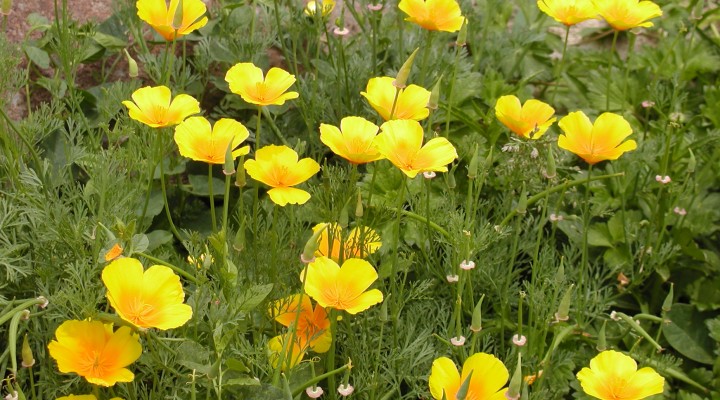Rather than just letting your flowerbed go dormant in the winter, consider this — here in northern California, we can grow some fantastic winter flowers. It just takes a little planning ahead and sowing while it’s still warm. And hey, I get the fact that you may having some of that end-of-summer garden fatigue (too many tomatoes and zucchini, anyone?), and you may not feel like starting all over with another planting season yet. I have some of that myself right now! But your future self — your middle-of-December self who eagerly awaits the seed catalogs and starts dreaming of next spring’s garden — will thank you for doing just a *little* bit of work right now! Trust me, it’s not too hard. :)
Our best winter flowers around here include: California poppies, African daisies (Dimophotheca), snapdragons, calendula, stock (Matthiola), primrose, violets, and pansies. A few of those are best suited for direct sowing, because they’re easy, and in the case of California poppy, they have deep tap roots that don’t like transplanting anyway. For those that aren’t easy to direct sow, we’ll buy some plants later in the fall and fit them between what we’ve sown this week.
A tradition to honor my mother
A couple days ago, my mother would have been 80 years old. She only made it to 48, passing when I was only 24. That was a real life-defining time, and it was damn tough to get through. When I became a homeowner and rediscovered the love of gardening that she taught me, I started a tradition to honor her — I would plant my winter flower seeds on her birthday, September 1st.
It’s great timing for the flowers, because they need the weather to still be warm enough to foster good germination but to cool down soon, so the seedlings don’t whither in the heat. And it’s a great way for me to remember her and try to bring some of her loving energy into my garden once again.
So, this past Sunday, Santia and I spent some time in the garden, sprinkling California poppy seeds right into the middle of our many zinnia clumps and other flowers, knowing those flowers will get cut down later in the fall, and the poppies will be growing right at their feet, waiting to take over for the winter. We spread some African daisy seeds in patches here and there, trying not to overlap with the poppies much. We also had some old snapdragon seeds we gathered from our plants maybe five years ago, and we sprinkled some in strategic spots. We’re not sure how easy they are to sprout from direct sowing, but we’ll see what happens. We did the same with some Iceland poppy seeds we had gathered, although I haven’t had luck direct sowing them in the past. Plus, they may take a year of growth before they’ll flower, but we tried them anyway.
We intended to sow some calendula, too, but we felt that we’d covered the bed pretty well with the others and decided to stop. I may add some calendula soon to some of the raised veggie beds, but I’m planning to sow some spinach and lettuce and need to decide if there is room for the flowers.
How to do it right
We have a good layer of bark mulch on this flowerbed, so we want to be sure the seeds make it into the soil or at least in contact with the soil under the mulch. So, after sowing them, I came through with the rake and just scratched back and forth a bit to settle the seeds in. Then, I gave everything a nice surface watering. I’ll repeat the watering every few days, just lightly, so I don’t overwater the established plants, but enough to keep the top inch or less just moist.
Hopefully, we’ll have some beautiful flower photos in the middle of winter to show you! How about you? Have you tried this? Any tips to leave for other readers? Go ahead and leave them in the comments. Oh, and here’s a useful article from Sunset with some more ideas.
Update, Oct. 25th: this didn’t work. It’s late-October now, and I’ve only seen a few seedlings. I think two things went wrong:
- The most important is that the mulch was too thick, which is great for suppressing weeds and keeping moisture in for established plants, but it keeps the soil from warming enough to sprout new seeds. It’s also quite possible that many of the seeds never got in contact with actual soil and just didn’t stay moist enough if they were suspended in all that mulch. I also had planted spinach seeds in two of the raised beds, which also have a significant mulch of shredded cedar. They didn’t sprout, either. Ugh.
- I wasn’t consistent enough in watering the surface every few days.
Lessons learned: rake away the mulch before planting seeds, either scoop it out of the bed to be returned later or make some piles to just get it out of the way. Also, be sure to water the surface every day, especially when the temps stay high — we had a lot of days in the 90s in September.
We’re going to buy some flowers, spinach, and a few other plants tomorrow. It’s too late to start seeds again, and we want some winter beauty and munchies. I’ll update on how that goes.








